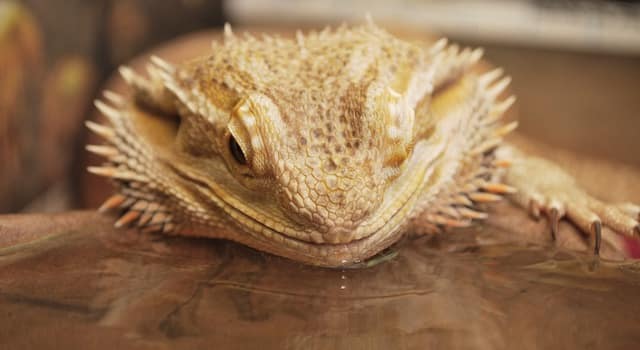
Introduction to Bearded Dragon Dehydration
Bearded dragons are native to the arid and semi-arid regions of Australia, such as deserts, woodlands, and savannas. Most of these arid regions are hot and dry with limited water resources, so they have adapted to conserve water to stay hydrated despite these unfavorable conditions. Hydration is important for keeping these desert-dwelling reptiles healthy and to prevent dehydration, which can quickly become fatal if left untreated. Bearded dragon dehydration can be both a sign and cause of several health issues, making it important to prevent them from becoming dehydrated in the first place.
In this article, we will discuss the importance of hydration for bearded dragons, debunking common misconceptions, and how to detect and prevent them from becoming dehydrated.
Why Hydration is Important for Bearded Dragons
Just like us, hydration is important for the health of our beloved bearded dragons. Proper hydration supports essential bodily functions such as metabolism, digestion, and temperature regulation. It’s important for preventing kidney and bladder issues, including kidney stones or urinary retention. Hydration also helps prevent shedding issues by keeping their skin healthy and supple.
Bearded dragons hydrate by drinking water or by absorbing moisture from their food, like juicy insects or vegetation. They must keep hydrated if they want to survive the hot and dry conditions in the wild and captivity. Remember, bearded dragons bask under heat lamps that can reach temperatures of up to 113°F (45°C) and can overheat and dehydrate quickly in these conditions. That’s why they must have access to fresh, clean water at all times to hydrate themselves throughout the day. Dehydration can be fatal for reptiles and it’s much easier to prevent than to treat.
Signs of Bearded Dragon Dehydration
- Lethargy or decreased activity
- Loose, wrinkly skin
- Sunken eyes
- Lack of appetite
- Dull appearance
- Darkened urates
- Panting
- Constipation
- Sticky saliva
There are various physical and behavioral signs to look out for in dehydrated bearded dragons. The most common signs would be lethargy, sunken eyes, and loose, wrinkly skin. Dehydration causes the skin to lose its elasticity and makes it more prone to dryness and cracks. Dehydrated bearded dragons will be weak and lethargic and seem reluctant to move, eat, or bask. They will refuse food and prefer to hide or lay in the cooler ends of the enclosure. Their saliva might appear sticky or stringy because dehydration causes the saliva to thicken. Another sign of dehydration is open-mouth breathing, as they try to take in moisture from the air.
Other than looking out for physical or behavioral signs of bearded dragon dehydration, you can perform a skin pinch test. You can do this by gently pinching the skin on their back or sides and observing how quickly it returns to normal. If it snaps back quickly, then it’s a sign that they are hydrated. However, if it takes a while to return to normal, it’s a sign of dehydration.
Common Misconceptions About Bearded Dragon Hydration
Myth #1: Bearded Dragons Absorb Water Through Baths or Cloacal Absorption
One of the most common misconceptions is that bearded dragons can absorb water through their cloaca or skin. Bathing or soaking bearded dragons in water is a common practice among hobbyists to encourage hydration. However, there has never been any scientific proof that bearded dragons can absorb water this way.
Unlike amphibians, they do not have permeable skin that can absorb moisture from the environment. Instead, their skin is designed to protect and minimize water loss in hot and dry conditions. This study explored the relationship between scale phenotype and evaporative water loss and found that bearded dragons with fewer scales tend to lose water faster than those with normal scalation. So this does show that their skin can affect hydration, but it does not actively absorb water like a sponge.
Furthermore, the misconception that bearded dragons can absorb water through their cloaca likely stems from their kidney’s ability to reabsorb water before it is excreted. Like many other reptiles, bearded dragons have a renal portal system that allows their kidneys to reabsorb water and electrolytes before it’s excreted. This helps them conserve water in dry environments, but it doesn’t mean that external water is absorbed through the cloaca.
Myth #2: Misting or Humid Enclosures Are Enough for Hydration
Although humidity can help hydrate your bearded dragon, it should not be the main form of hydration. Bearded dragons still need a water dish and moisture-rich foods in addition to regular mistings and humidity. Regularly misting the enclosure is recommended to maintain an ideal humidity range, which helps to keep their skin hydrated and aids in the shedding process. It also encourages them to lick up water droplets that might have landed on their faces or the sides of the enclosure.
Causes of Bearded Dragon Dehydration
1. Lack of Proper Water Intake
In the wild, bearded dragons get most of their water intake from vegetation and puddles left behind after rainfall. In captivity, they can become dehydrated if they don’t have access to fresh water or don’t eat enough foods with a high water content. Bearded dragons will drink from the water dish throughout the day when they feel thirsty, so make sure that you keep it refilled with clean, fresh water.
2. High Temperatures
Bearded dragons have adapted to the high temperatures in their wild habitat. Still, prolonged exposure to high temperatures and a lack of proper water intake puts them at risk of becoming dehydrated. They need to have different temperature zones throughout the enclosure so that they can warm up and cool down properly. Otherwise, they can quickly overheat and become dehydrated. Always make sure that the enclosure has a cool side with a temperature range of 77°F to 84°F (25°C – 29°C) so that they can escape the heat. Bearded dragons will move between the different temperature zones throughout the day to thermoregulate, which is important for preventing bearded dragon dehydration.
3. Low Humidity
Bearded dragons need between 30%-40% humidity for proper hydration. Low humidity levels could potentially cause them to lose moisture more quickly through their respiratory systems. This is because dry air increases the evaporation rate of the moisture from their respiratory tract each time they exhale. Keeping their environment humid through regular misting can help reduce excessive water loss through evaporation.
4. Illness or Disease
Bearded dragon dehydration can be the result of or cause of several health issues, including:
- Metabolic bone disease (MBD): This condition can cause weak and deformed bones, making it difficult for bearded dragons to move comfortably and drink independently. They may also struggle to get enough moisture from their diet or to thermoregulate properly, which can worsen dehydration.
- Impaction: This refers to a blockage in their digestion system, usually caused by improper temperatures or ingesting inedible items (such as loose substrate). Impacted bearded dragons often lose their appetite and may stop drinking water. It can also prevent them from absorbing moisture from their food properly.
- Kidney stones: Dehydration can put your bearded dragon at risk of developing kidney stones. Their kidneys must work extra hard to filter waste and conserve water when the body is dehydrated, which can cause kidney stones to form. Kidney stones are painful and can lead to more serious issues like kidney failure or blockages if left untreated.
- Organ failure: Severe dehydration can eventually lead to organ failure due to reduced blood flow to vital organs and impaired kidney function. The kidneys need adequate hydration to filter waste and maintain a balance of electrolytes. An electrolyte imbalance could cause muscle weakness and interfere with how well their organs function.
Preventing Bearded Dragon Dehydration
Thankfully, it is relatively easy to prevent your bearded dragon from becoming dehydrated. The best way to prevent dehydration is by ensuring that your bearded dragon always has access to fresh, clean water in their enclosure to drink. It’s a good idea to place at least two shallow water dishes throughout the enclosure just in case something happens to one of them.
Bearded dragons primarily stay hydrated by eating vegetation with high water content, so it’s important to include similar foods into their daily diet of fresh greens and veggies. Make sure that you are feeding moisture-rich vegetables such as mustard greens, collard greens, cucumber, butternut squash, and kale. It’s also a good idea to mist down your bearded dragon’s daily salad for extra hydration. Feeder insects can also provide additional hydration if they are gut-loaded with water-rich fruits and vegetables.
To maintain an ideal humidity range and to encourage drinking, you should regularly mist the enclosure throughout the day. Make sure that the humidity range stays between 30-40% because excessively humid conditions aren’t good for bearded dragons. A proper temperature gradient can also help prevent dehydration. They should be able to move between the warm and cool temperature zones for proper thermoregulation, which prevents them from overheating and becoming dehydrated.
Lastly, you can encourage your bearded dragon to drink more water by soaking them in a shallow dish of water. This method only works if your bearded dragon drinks the water during the soak because the water won’t be absorbed through their skin or cloaca. These baths also work great for loosening stuck sheds and alleviating dry skin.
Treating Bearded Dragon Dehydration
Mild cases of bearded dragon dehydration can be treated at home. However, it’s always a good idea to consult with a veterinarian if you notice signs of dehydration or if their condition does not improve. Treating dehydration involves feeding more vegetables high in water, frequent soaks, and regularly misting down their enclosure and daily salad.
Try to start by soaking your bearded dragon in shallow, room-temperature water for about 15-20 minutes to encourage them to drink. The water should be shallow and never rise above their shoulders or head. Offer them more vegetables with a high water content. Cucumbers are often preferred for hydration because they contain about 90-95% water, making them a refreshing snack for a dehydrated bearded dragon.
It’s important to take your bearded dragon to an emergency reptile veterinarian right away if they don’t seem to be getting better or they are showing concerning signs of dehydration. Panting, lethargy, sunken eyes, and sticky saliva are all signs of severe dehydration that require special treatment from a veterinarian.
A severely dehydrated bearded dragon may be too weak to eat or drink themselves, so a vet may administer fluids subcutaneously (under the skin) to quickly rehydrate them. The vet may also offer electrolyte solutions to replenish lost or imbalanced electrolytes. Your bearded dragon may have to stay at the vet, where they will be closely monitored until they respond to treatment.
Conclusion
Bearded dragon dehydration is a serious issue that can quickly become fatal and impact the health and well-being of your pet. As a responsible owner, you should always make sure that your bearded dragon has access to fresh, clean water to keep hydrated. You can also encourage them to stay hydrated by misting their enclosure and food and ensuring they have the correct temperature zones to properly thermoregulate. It’s important to regularly do the skin pinch test to monitor your bearded dragon’s hydration levels throughout the day and increase their water intake as necessary.



